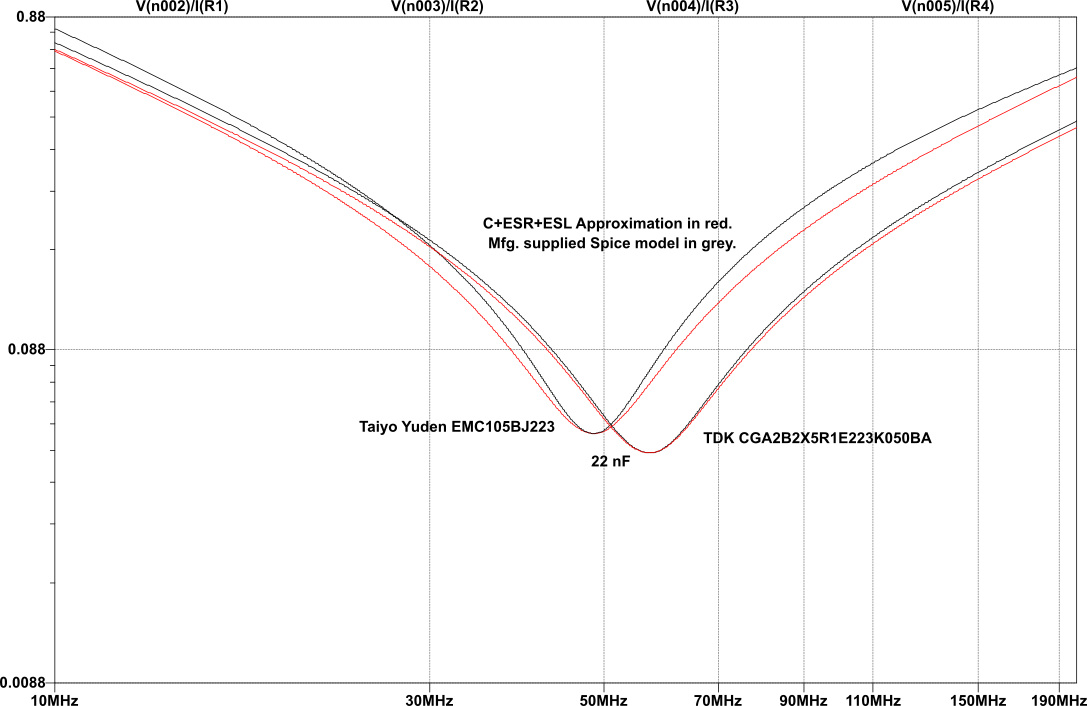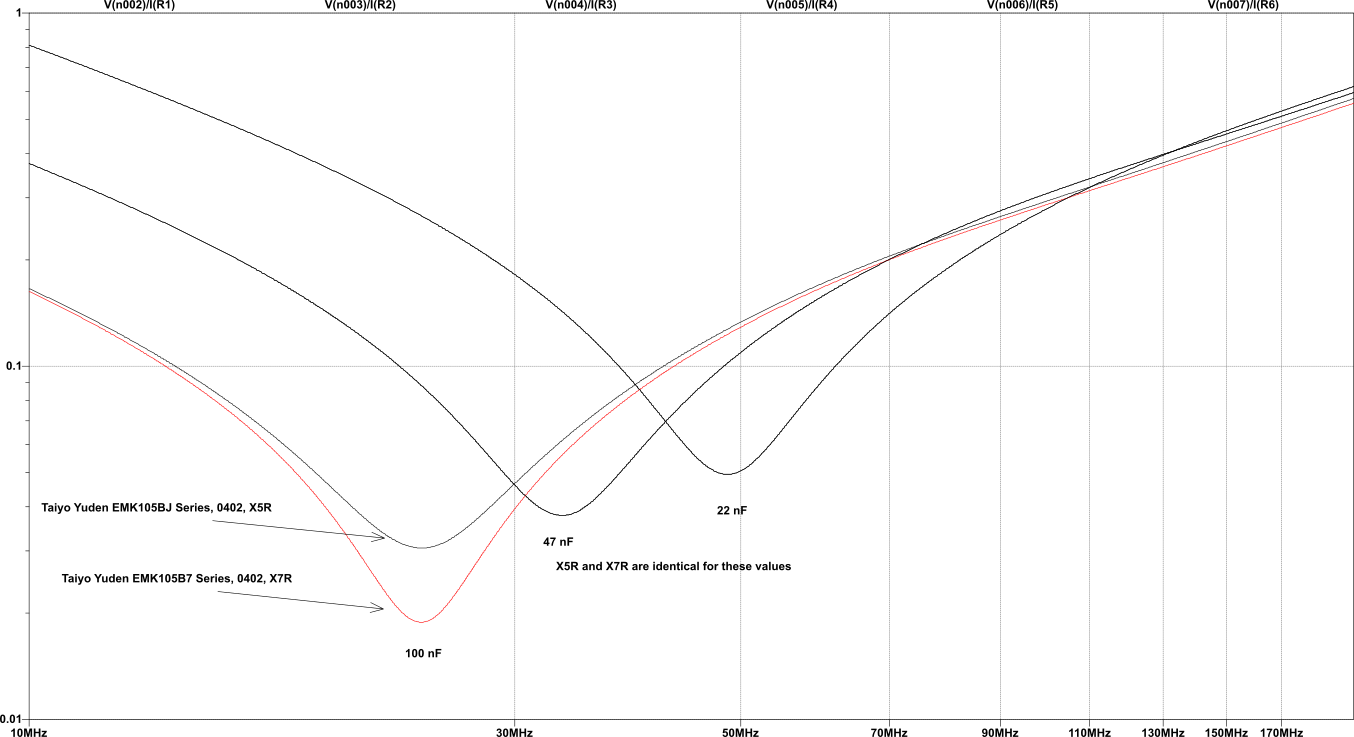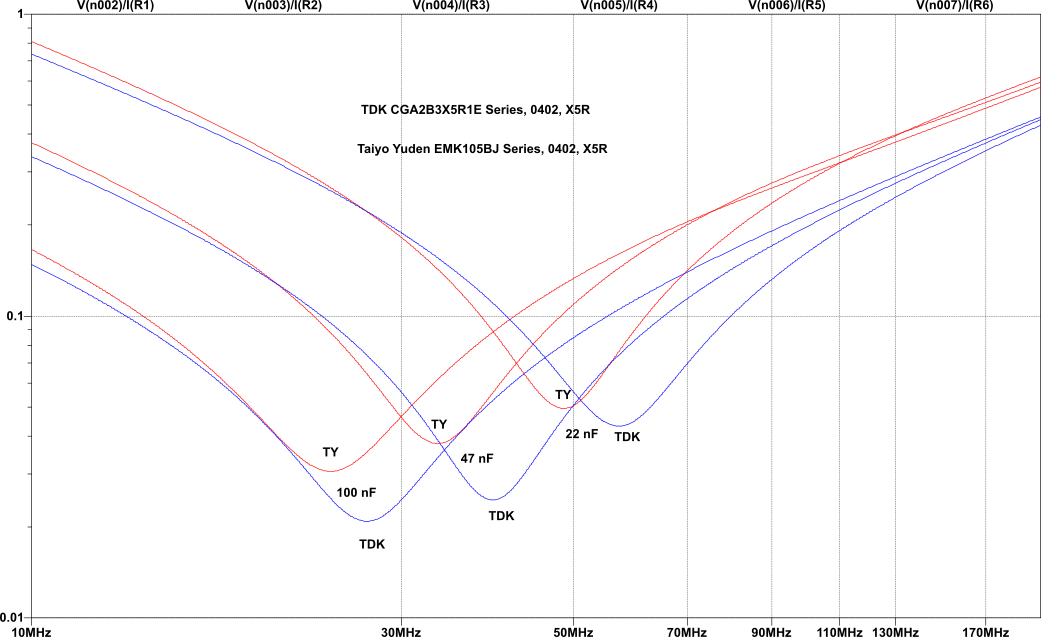The Nature Of Capacitors, Part 2
In Part 2 of The Nature Of Capacitors, I will dive more into simulation models and how caps can vary. I should note, however, that I am focusing on caps that you would use for decoupling, although much of this applies to other types of caps as well.
If you haven’t read Part 1, now is a good time to do that.
As before, download Nature_Of_Caps2 to follow along. You’ll need LTspice.
This article is also critical of several capacitor manufacturers. I welcome input from any of the manufacturers and will gladly update this article if something is wrong, or if the manufacturer changes things on their side.
Types of Simulation Models
For cap simulations, there are basically two ways to model a cap. You can use a full Spice model, or you can approximate it by specifying Capacitance, ESL, and ESR. There are pros and cons to each approach, and neither one should be your go-to method.
A third option are the capacitors built into LTspice. But as I mentioned in Part 1, the built in caps are not very accurate and are often missing ESL and ESR parameters entirely. I do not recommend using the built in models unless you have properly evaluated them.
Spice Models
You might think that manufacturer supplied Spice models would be the way to go. They at least have the hope of being the most accurate, and you might assume that the manufacturer tries to do that. Unfortunately that isn’t always the case. For starters, many manufacturers don’t provide Spice models.
Mfg with Spice Models: Taiyo Yuden, TDK
Mfg without Spice Models: Kemet, Venkel, Yageo, Johanson Dielectrics, Kemet, Murata, and Samsung.
Available through a paywall: AVX.
It is entirely possible that if you ask nicely some of those manufacturers would provide Spice models— but why? Accurate models are increasingly necessary for important design decisions so why wouldn’t they provide those on their website? It makes me wonder how much they value their customers.
It should be no great surprise that I use Taiyo Yuden and TDK as examples in this article.
C+ESL+ESR Models
It is fairly easy to create your own simple capacitor model just by entering the capacitance, ESL, and ESR parameters into LTspice (and other simulators). As you will see later, this type of model is fairly good, too!
To get started, you need to have the impedance graph of your cap. Fortunately, almost every cap manufacturer will give you this graph (shame on you, Yageo!). From the graph, you need to get the ESR value which is the impedance at the bottom of the “V”. Next, you need to know the resonant frequency (also the center of the V).
From there, it is easy to calculate the ESL. The formula is
ESL = 1 / ((2*Pi*Frequency)^2 * Capacitance)
Or the spreadsheet formula is:
ESL_pH =1000000000000/(power(2*pi()*Frequency_MHz*1000000,2)*(Capacitance_nF/1000000000))
If you don’t want to bother with calculations or spreadsheets, you can just eyeball it with trial and error. But trust me, doing the calculations is faster and more accurate.
Once you have C, ESL, and ESR all you need to do is plug them into the simulation.
Comparing Models
The graph below compares two Spice models with the simplified models (C+ESR+ESL). The two spice models are for 22 nF, 0402, X5R caps from Taiyo Yuden and TDK.
You’ll notice that the simplified model matches the spice model fairly accurately, but not perfectly. But more importantly, the two different manufacturers of caps differ more! What’s not shown is the variation due to component tolerances, which should also be larger than the difference between two two types of models.
The takeaway here is that Spice models are nice, but for most things a simplified models is just fine.
Model Citizen
I was going to show a graph comparing X7R and X5R capacitor types, but while preparing that I found out something that’s much more important and interesting.
Of course, there is significant differences between X7R and X5R. In this case X7R has a lower ESR, but the same ESL. But this is not always the case! You can never assume that X7R is always better than X5R, or vice versa. Only the impedance graph can tell you what you need to know.
The more interesting thing about this graph is that for the smaller two capacitor values, the X7R and X5R lines are identical. This raised all sorts of red-flags with me, so I compared the actual text files for the Spice models. Other than the comments, the files were identical. 43 different parameters were identical to 5 or 6 decimal places. What’s more likely? Someone cut and pasted the spice model, or these two caps of different compositions are actually identical to that degree? These spice models from Taiyo Yuden are faulty.
While we hope that the information we get from manufacturers is accurate, we must always consider the possibility that it isn’t. This is obviously true for Spice models, but also data sheets, application notes, etc.
That being said… Based on the consistency of data I am assuming that the X7R models are faulty but the X5R models are fine. This is little more than a guess, but it is good enough for this article.
Different Capacitance, Same ESL
I have heard in many places, “Capacitors of different values but the same package will have the same ESL”. I’ve found this to be “partially true”.
This graph shows different capacitor values from the same capacitor series. And, indeed, it does show that they all have approximately the same ESL. Close enough for us, at least.
The graph also shows that ESR increases as capacitance decreases. This will be important in later articles when we discuss why we put more low-value caps in parallel than high-value caps.
We have one outlier, 470 nF. It’s ESR is higher than what the trend would suggest. I’m not sure why this is, but I did notice that the Taiyo Yuden part number used for this component is slightly different than the others. The base series and capacitor value are good, but one of those “insignificant” digits at the end is different. Digging a bit further, I found that this cap is 0.3 mm thick and all of the others are 0.5 mm thick. Details matter!
Comparing Different Manufacturers
We’ve compared different dielectrics, different model types, and different cap values. Now let’s compare different manufacturers! The graph below shows caps from Taiyo Yuden and TDK, in three different values.
There are significant differences in ESL and ESR even though all the caps are 0402 and X5R. These differences cause significant differences in resonant frequency as well.
Above 1 GHz
It should be noted that strange things happen above 1 GHz. Most capacitor models break down at those frequencies. Hopefully I will address this in a future article, but for now don’t trust your simulations at those frequencies.
Multiple Caps In Parallel
In part 1 of this series, I mentioned a way to easily simulate many caps in parallel using a trick in LTspice. Unfortunately, this doesn’t work when using Spice models. Fortunately you can still do this when using the simplified models.
Conclusion
A fair amount of paranoia is called for when modeling caps. Everything can impact the important characteristics of a cap. Cap tolerances are also fairly loose. And data from the manufacturers is questionable.
The best thing is to not assume anything about a cap, and instead rely on the (hopefully accurate) data from the manufacturer about that exact part number.
But creating your own models is quick and easy. Simulating the effects of caps is also easy. It is in your best interest to not take caps for granted.




